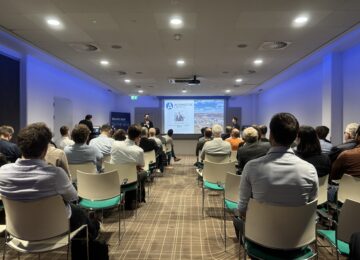Publication of the Integral Infrastructure Outlook 2030-2050, II3050 Edition 2
The updated Integral Infrastructure Outlook 2030-2050, II3050 Edition 2* has been published. The main recommendations of the II3050 Edition 2 on energy storage are listed here.
Energy storage plays an important role in all the scenarios studied for balancing energy supply and demand on different time scales. This includes both short- to medium-term energy storage (electricity and heat storage) and long-term energy storage in the form of gases (molecule storage).
The scenarios show that 40-70 GW of electricity storage is needed by 2050. In the sensitivity scenarios taking less short-term electricity storage into account, the electricity price could increase by up to 140%, shutdown industry by 97% and curtailment by 280%. Energy Storage NL (ESNL) reiterates that along with growth in variable renewable generation (wind and solar), strong growth in flexibility in the form of energy storage is also needed to keep the future system robust and affordable.
The purpose of this exploration is to develop the insights into energy infrastructure, flexibility resources and system integration needed for a reliable, effective and robust climate-neutral energy system in 2050. According to Hans-Peter Oskam, director of policy and energy transition Netbeheer Nederland, the pace of implementation must be further accelerated to achieve the 2050 climate ambitions. Furthermore, we will have to adapt our behavior to the new energy system, which is much more erratic than we are used to so far. A major boost is still needed to have sufficient flex solutions, such as energy storage and conversion, available in time, and time is needed to learn new behavior. Flex must become the new normal, but We are not there yet according to Hans-Peter Oskam.
* II3050 Edition 2 is an update and deepening of II3050 Edition 1 from 2021. The first update of the scenarios, the II3050 scenarios, was published in June 2023.
Below are the key conclusions and recommendations from the II3050 Issue 2 for the industry and administrators.
- In accelerating a carbon-free electricity system, preconditions such as hydrogen production and storage, renewable generation, storage, conversion and infrastructure must be ensured. Ensure effective and feasible climate policies, taking into account physical borders and periodic tightening of national programs using infrastructure analyses. According to ESNL, there is much ambiguity about what role conversion and energy storage can have per region and municipality and there are different implementation strategies among Grid Operators. ESNL wants to emphasize that integration of energy infrastructure analysis, flexibility and implementation capacity is needed to identify bottlenecks and make more effective policy choices. This will benefit private and public investment.
- Establish a security of supply standard for each energy carrier, and possibly sector, and/or review existing standards. Several standards currently exist for electricity and gas. For hydrogen and for heat they are still missing so there is a lot of uncertainty what role these energy carriers will have. ESNL underlines that a decision is needed on what is expected from the future sustainable energy system for all energy carriers and customers in order to make the right investments in infrastructure and flexibility resources at the right time. The discussion should focus on the desired level of security of supply, acceptable costs and fair access to energy during scarcity.
- Reserve sufficient space at all levels of government for renewable generation, infrastructure, flexibility and storage in a timely manner to meet the pace of transition. This includes spatial reservations for electricity and heat generation, as well as infrastructure at the national, provincial and municipal levels, including cables, pipes and stations.
- Establish a national energy transition implementation plan that addresses the transition of the four energy chains (electricity, hydrogen, heat and carbon) at the national and regional levels. This plan should provide clarity to citizens and businesses, help governments prepare, and support grid companies in personnel and material planning to make the energy transition feasible.
Energy Storage NL endorses the above recommendations. In the discussions ESNL has with the sector and municipalities it is clear that there is a demand for a long-term vision and clarity on what is required from energy storage systems.
On the topic of flexibility
- Develop a policy framework that allows for sufficient flexible capacity, while keeping the rules simple and the business aspects attractive. The future scenarios indicate a growing gap between supply and demand for all energy carriers. The current market rules (classification energy storage and conversion/ transmission tariffs/ subsidy) are not cost-effective for the desired amount of decentralized flexible capacity - according to ESNL and the II3050 ed. 2. The policy framework should include development paths for flexibility resources and set minimum capacity standards to be controlled in each case. (Example: xGW and xGWh storage capacity and capacity in province X)
- Encourage flexible energy demand behavior in all sectors with financial incentives. Set concrete goals and monitor progress. Flexible energy demand behavior that moves with supply reduces the need for investment in flexibility options and energy infrastructure. Financial incentives should be introduced to encourage this behavior, and agreements should be made with stakeholders, including monitoring.
- Manage the location and method of deployment of flexibility options so as not to increase transportation needs. This can be achieved through differentiation in network tariffs, prioritizing connection for flexibility options, revision of bidding zones and other methods. For this we already saw several proposals, such as the development of alternative transport rights and the ACM-consultation for a prioritization framework for transportation requests.
Electricity storage
- Encourage adoption of circular strategies in all sectors to reduce import dependence on scarce minerals and metals. Scaling up sustainable production chains requires work on circular strategies rethink, reduce, repair and re-use, thus reducing import dependence on scarce minerals and metals. ESNL would again like to alert the industry to the adoption of new European battery recycling legislation. Read our message for more information. ESNL will expand on this topic in future coverage.
Molecule Storage
- Green hydrogen coupled with wind-on-sea needs to be better unlocked in the system. Storage plays a crucial role here, for example in salt caverns and empty gas fields. By making clear choices now, for example in the Mining Act, the Netherlands can maintain a strong position on seasonal storage and strategic reserves of renewable energy. In discussions with ESNL's supporters, it emerged very strongly that the choice for the number of salt caverns must be made very quickly because of the long lead time to prepare a cavern for molecular storage (hydrogen, compressed air, other hydrogen derivatives).
- Make concrete for whom, in which areas and when hydrogen will have a role, who is responsible for the realization of the necessary (regional) infrastructure and what requirements this hydrogen network must meet. With concrete indications, the planning of new and conversion projects from the regional gas grid to hydrogen can be taken into account. It will also provide clarity for companies now in the process of making strategic choices about their path to sustainability.
Heat Storage
- For needed grid upgrades, prioritize neighborhoods where the plans and preconditions are in place, and which are clustered in one move to a sustainable end solution, such as full electrification. This requires an adjustment of current rules for, and working methods of, regional grid operators.
ESNL sees in the various scenarios that the character of heat exchange changes enormously towards 2050: from 'heat networks' in industry and agriculture - mainly accounting, little infra - to large-scale residential use of heat, which requires a lot of infra. There are also many changes in greenhouse horticulture: from many greenhouses with a CHP and with little heat infra to, for example, shared geothermal wells and thus the need for more heat infra. These changes occur in every scenario. ESNL wants to emphasize that several heat storage technologies are not named that could potentially contribute a lot to the flexibility demand in the Netherlands.
The final report is here to be found. The appendix to the report can be found here and the recommendations of the report here.





